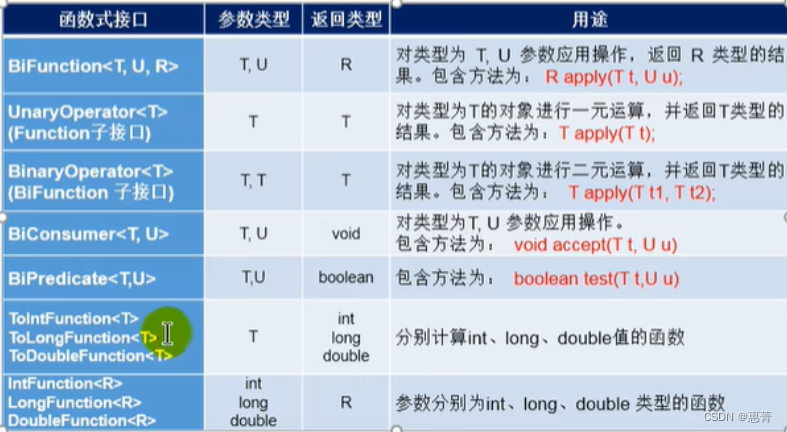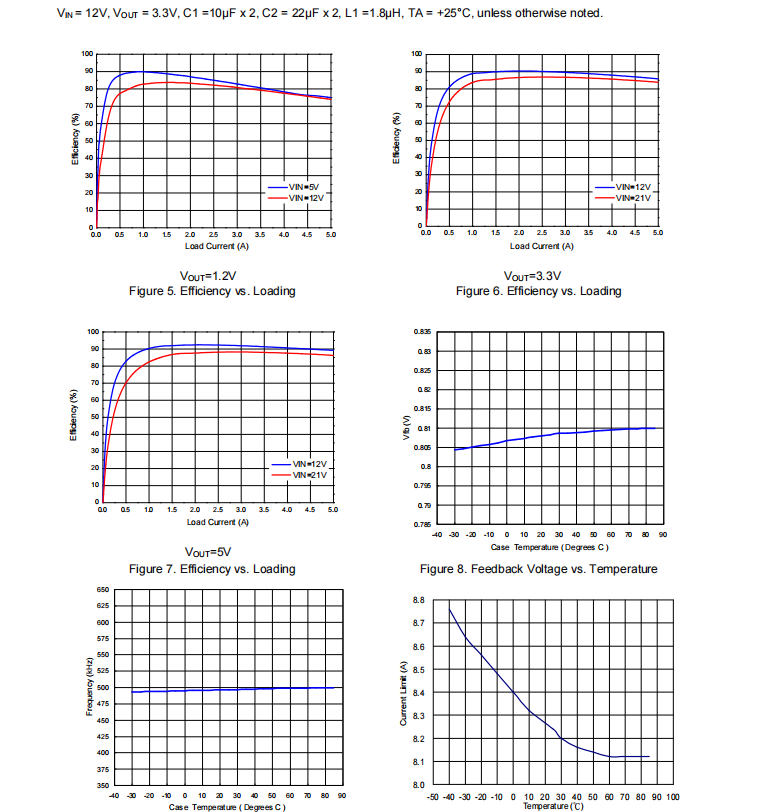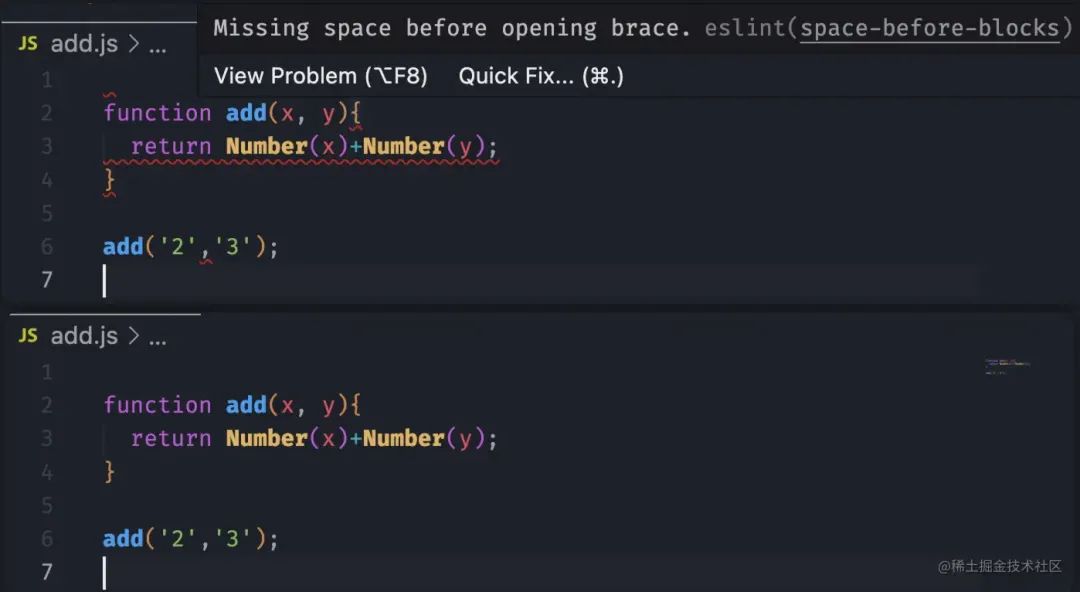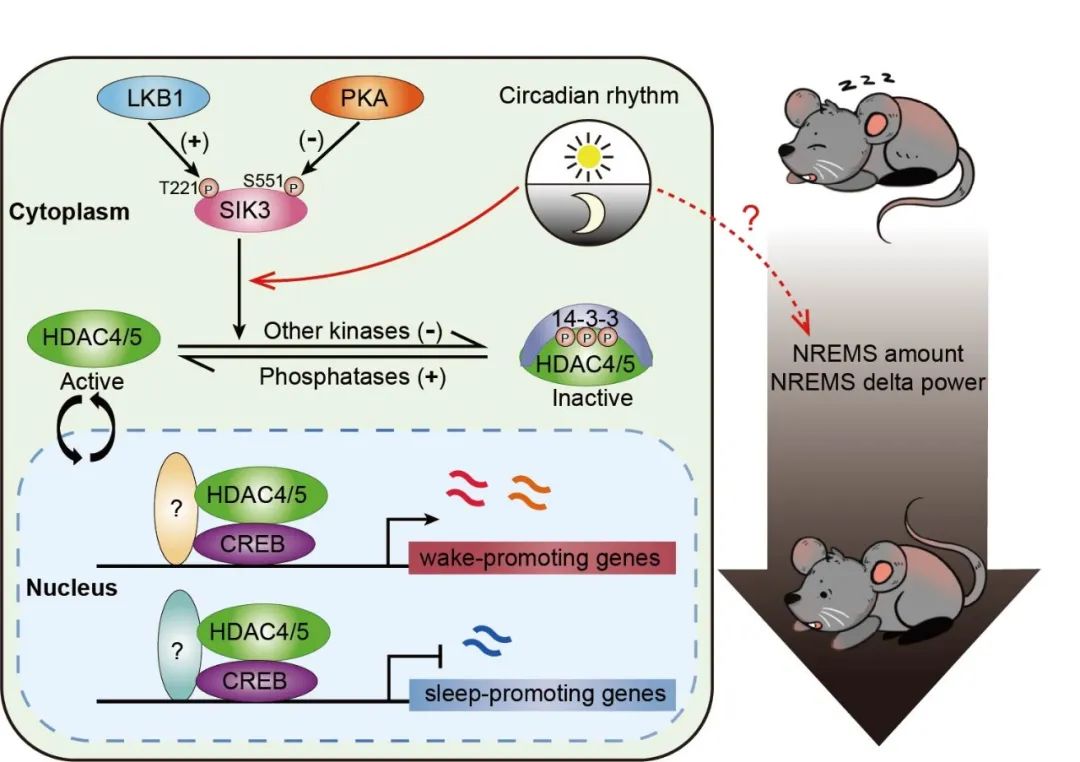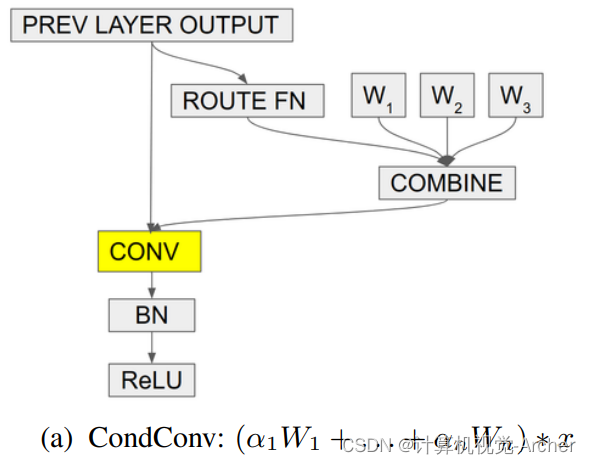经典神经网络(1)LeNet
1、卷积神经网络LeNet
之前对于Fashion-MNIST服装分类数据集,为了能够应⽤softmax回归和多层感知机,我们⾸先将每个大小为28 × 28的图像展平为⼀个784维的固定⻓度的⼀维向量,然后⽤全连接层对其进⾏处理,此时我们丢失了图像的空间结构。
pytorch基础操作(四)softmax回归手动实现以及pytorch的API实现
pytorch基础操作(五)多层感知机的实现
通过卷积层的处理⽅法,我们可以在图像中保留空间结构。同时,⽤卷积层代替全连接层的另⼀个好处是:模型更简洁、所需的参数更少。
1.1 LeNet简述
1.1.1 LeNet概述
LeNet是最早发布的卷积神经⽹络之⼀,因其在计算机视觉任务中的⾼效性能⽽受到⼴泛关注。这个模型是由AT&T⻉尔实验室的研究员Yann LeCun在1989年提出的(并以其命名),⽬的是识别图像中的⼿写数字。
当时,LeNet取得了与⽀持向量机(support vector machines)性能相媲美的成果,成为监督学习的主流⽅法。LeNet被⼴泛⽤于⾃动取款机(ATM)机中,帮助识别处理⽀票的数字。
1.1.2 LeNet的原始的网络架构

注:
feature map的描述有两种:channel first,如256x3x3;channel last,如3x3x256。
LeNet 网络包含了卷积层、池化层、全连接层,这些都是现代CNN 网络的基本组件。
-
输入层:二维图像,尺寸为
32x32。 -
C1、C3、C5层:二维卷积层。其中
C5将输入的feature map(尺寸16@5x5)转化为尺寸为120x1x1的feature map,然后转换为长度为120的一维向量。这是一种常见的、将卷积层的输出转换为全连接层的输入的一种方法。
-
S2、S4层:池化层。使用sigmoid函数作为激活函数。后续的
CNN都使用ReLU作为激活函数。 -
F6层:全连接层。 -
输出层:由欧式径向基函数单元组成。
后续的
CNN使用softmax输出单元。
| 网络层 | 核/池大小 | 核数量 | 步长 | 输入尺寸 | 输出尺寸 |
|---|---|---|---|---|---|
| INPUT | - | - | - | - | 1@32x32 |
| C1 | 5x5 | 6 | 1 | 1@32x32 | 6@28x28 |
| S2 | 2x2 | - | 2 | 6@28x28 | 6@14x14 |
| C3 | 5x5 | 16 | 1 | 6@14x14 | 16@10x10 |
| S4 | 2x2 | - | 2 | 16@10x10 | 16@5x5 |
| C5 | 5x5 | 120 | 1 | 16@5x5 | 120@1x1 |
| F6 | - | - | - | 120 | 84 |
| OUTPUT | - | - | - | 84 | 10 |
1.2 架构图解释
我们将对原始模型做了⼀点⼩改动,去掉了最后⼀层的⾼斯激活,简化为下图。

-
每个卷积块中的基本单元是
⼀个卷积层、⼀个sigmoid激活函数和平均汇聚层。请注意,虽然ReLU和最⼤汇聚层更有效,但它们在20世纪90年代还没有出现。 -
每个卷积层使⽤5 × 5卷积核和⼀个sigmoid激活函数。这些层将输⼊映射到多个⼆维特征输出,通常同时增加通道的数量。第⼀卷积层有6个输出通道,⽽第⼆个卷积层有16个输出通道。每个2 × 2池操作(步幅2)通过空间下采样将维数减少4倍。卷积的输出形状由批量⼤大小、通道数、高度、宽度决定。
-
为了将卷积块的输出传递给稠密块,我们必须在⼩批量中展平每个样本。我们将这个四维输⼊转换成全连接层所期望的⼆维输⼊。这⾥的⼆维表示的第⼀个维度索引小批量中的样本,第⼆个维度给出每个样本的平⾯向量表⽰。LeNet的稠密块有三个全连接层,分别有120、84和10个输出。因为我们在执⾏分类任务,所以输出层的10维对应于最后输出结果的数量。
1.3 LeNet在Fashion-MNIST数据集上的应用代码
1.3.1 定义LeNet模型
import torch.nn as nn
import torch
class LeNet5(nn.Module):
def __init__(self):
super().__init__()
self.model = nn.Sequential(
nn.Conv2d(in_channels=1, out_channels=6, kernel_size=5, padding=2, stride=1),
nn.Sigmoid(),
nn.AvgPool2d(kernel_size=2,stride=2),
nn.Conv2d(in_channels=6, out_channels=16, kernel_size=5),
nn.Sigmoid(),
nn.AvgPool2d(kernel_size=2,stride=2),
nn.Flatten(),
nn.Linear(in_features=16 * 5 * 5, out_features=120),
nn.Sigmoid(),
nn.Linear(in_features=120, out_features=84),
nn.Sigmoid(),
nn.Linear(in_features=84, out_features=10)
)
def forward(self, X):
X = self.model(X)
return X
if __name__ == '__main__':
net = LeNet5()
# 测试神经网络是否可运行
# inputs = torch.rand(size=(1, 1, 28, 28), dtype=torch.float32)
# outputs = net(inputs)
# print(outputs.shape)
# 查看每一层输出的shape
X = torch.rand(size=(1, 1, 28, 28), dtype=torch.float32)
for layer in net.model:
X = layer(X)
print(layer.__class__.__name__, 'output shape:', X.shape)
Conv2d output shape: torch.Size([1, 6, 28, 28])
Sigmoid output shape: torch.Size([1, 6, 28, 28])
AvgPool2d output shape: torch.Size([1, 6, 14, 14])
Conv2d output shape: torch.Size([1, 16, 10, 10])
Sigmoid output shape: torch.Size([1, 16, 10, 10])
AvgPool2d output shape: torch.Size([1, 16, 5, 5])
Flatten output shape: torch.Size([1, 400])
Linear output shape: torch.Size([1, 120])
Sigmoid output shape: torch.Size([1, 120])
Linear output shape: torch.Size([1, 84])
Sigmoid output shape: torch.Size([1, 84])
Linear output shape: torch.Size([1, 10])
-
在整个卷积块中,与上⼀层相⽐,每⼀层特征的⾼度和宽度都减⼩了。
-
第⼀个卷积层使⽤2个像素的填充,来补偿5 × 5卷积核导致的特征减少。
-
第⼆个卷积层没有填充,因此⾼度和宽度都减少了4个像素。
-
-
随着层叠的上升,通道的数量从输⼊时的1个,增加到第⼀个卷积层之后的6个,再到第⼆个卷积层之后的16个。同时,每个汇聚层的⾼度和宽度都减半。
-
最后,每个全连接层减少维数,最终输出⼀个维数与结果分类数相匹配的输出。
1.3.2 读取Fashion-MNIST数据集
# 通过框架中的内置函数将Fashion-MNIST数据集下载并读取到内存中
# Fashion-MNIST是⼀个服装分类数据集,由10个类别的图像组成
# Fashion-MNIST由10个类别的图像组成,每个类别由训练数据集(train dataset)中的6000张图像和测试数据集(test dataset)中的1000张图像组成。
# 因此,训练集和测试集分别包含60000和10000张图像。
'''
读取服装分类数据集 Fashion-MNIST
'''
import torchvision
import torch
from torch.utils import data
from torchvision import transforms
def get_dataloader_workers():
"""使⽤4个进程来读取数据"""
return 4
def get_mnist_data(batch_size, resize=None):
trans = [transforms.ToTensor()]
if resize:
# 还接受⼀个可选参数resize,⽤来将图像⼤⼩调整为另⼀种形状
trans.insert(0,transforms.Resize(resize))
trans = transforms.Compose(trans)
# 需要下载,可以设置为True
mnist_train = torchvision.datasets.FashionMNIST(
root='./data',train=True,transform=trans,download=False
)
mnist_test = torchvision.datasets.FashionMNIST(
root='./data',train=False,transform=trans,download=False
)
# 数据加载器每次都会读取⼀⼩批量数据,⼤⼩为batch_size。通过内置数据迭代器,我们可以随机打乱了所有样本,从⽽⽆偏⻅地读取⼩批量
# 数据迭代器是获得更⾼性能的关键组件。依靠实现良好的数据迭代器,利⽤⾼性能计算来避免减慢训练过程。
train_iter = data.DataLoader(mnist_train,batch_size=batch_size,shuffle=True,num_workers=get_dataloader_workers())
test_iter = data.DataLoader(mnist_test,batch_size=batch_size,shuffle=True,num_workers=get_dataloader_workers())
return (train_iter,test_iter)
batch_size = 256
train_iter,test_iter = get_mnist_data(batch_size)
1.3.3 定义通用的网络模型训练函数
1、先定义几个类,用来计算精确率,画图,计算训练时间等
累加类Accumulator
'''
定义⼀个实⽤程序类Accumulator,⽤于对多个变量进⾏累加
'''
class Accumulator():
"""在n个变量上累加"""
def __init__(self, n):
self.data = [0.0] * n
def add(self, *args):
self.data = [a + float(b) for a,b in zip(self.data, args)]
def reset(self):
self.data = [0.0] * len(self.data)
def __getitem__(self,index):
return self.data[index]
时间类Timer
import time
class Timer:
"""Record multiple running times."""
def __init__(self):
"""Defined in :numref:`subsec_linear_model`"""
self.times = []
self.start()
def start(self):
"""Start the timer."""
self.tik = time.time()
def stop(self):
"""Stop the timer and record the time in a list."""
self.times.append(time.time() - self.tik)
return self.times[-1]
def avg(self):
"""Return the average time."""
return sum(self.times) / len(self.times)
def sum(self):
"""Return the sum of time."""
return sum(self.times)
def cumsum(self):
"""Return the accumulated time."""
return np.array(self.times).cumsum().tolist()
绘图类Animator
from matplotlib import pyplot as plt
from IPython import display
def set_axes(axes, xlabel, ylabel, xlim, ylim, xscale, yscale, legend):
"""设置matplotlib的轴"""
axes.set_xlabel(xlabel)
axes.set_ylabel(ylabel)
axes.set_xscale(xscale)
axes.set_yscale(yscale)
axes.set_xlim(xlim)
axes.set_ylim(ylim)
if legend:
axes.legend(legend)
axes.grid()
class Animator():
"""在动画中绘制数据"""
def __init__(self, xlabel=None, ylabel=None, legend=None, xlim=None,
ylim=None, xscale='linear', yscale='linear',
fmts=('-', 'm--', 'g-.', 'r:'), nrows=1, ncols=1,
figsize=(3.5, 2.5)):
# 增量地绘制多条线
if legend is None:
legend = []
self.fig, self.axes = plt.subplots(nrows, ncols, figsize=figsize)
if nrows * ncols == 1:
self.axes = [self.axes, ]
# 使用lambda函数捕获参数
self.config_axes = lambda: set_axes(
self.axes[0], xlabel, ylabel, xlim, ylim, xscale, yscale, legend)
self.X, self.Y, self.fmts = None, None, fmts
def add(self, x, y):
# 向图表中添加多个数据点
if not hasattr(y, "__len__"):
y = [y]
n = len(y)
if not hasattr(x, "__len__"):
x = [x] * n
if not self.X:
self.X = [[] for _ in range(n)]
if not self.Y:
self.Y = [[] for _ in range(n)]
for i, (a, b) in enumerate(zip(x, y)):
if a is not None and b is not None:
self.X[i].append(a)
self.Y[i].append(b)
self.axes[0].cla()
for x, y, fmt in zip(self.X, self.Y, self.fmts):
self.axes[0].plot(x, y, fmt)
self.config_axes()
display.display(self.fig)
display.clear_output(wait=True)
2、定义训练函数
import torch.nn as nn
from AccumulatorClass import Accumulator
def accuracy(y_hat, y):
"""计算预测正确的数量"""
if len(y_hat.shape) > 1 and y_hat.shape[1] > 1:
y_hat = y_hat.argmax(axis=1)
cmp = y_hat.type(y.dtype) == y
return float(cmp.type(y.dtype).sum())
def evaluate_accuracy_gpu(net, data_iter, device=None):
"""使⽤GPU计算模型在数据集上的精度"""
if isinstance(net, nn.Module):
net.eval() # 设置为评估模式
if not device:
device = next(iter(net.parameters())).device
# 正确预测的数量,总预测的数量
metric = Accumulator(2)
with torch.no_grad():
for X, y in data_iter:
if isinstance(X, list):
# BERT微调所需的
X = [x.to(device) for x in X]
else:
X = X.to(device)
y = y.to(device)
metric.add(accuracy(net(X), y), y.numel())
return metric[0] / metric[1]
from AnimatorClass import Animator
from TimerClass import Timer
def train_ch(net, train_iter, test_iter, num_epochs, lr, device):
"""⽤GPU训练模型"""
def init_weights(m):
if type(m) == nn.Linear or type(m) == nn.Conv2d:
nn.init.xavier_uniform_(m.weight)
# 初始化权重
net.apply(init_weights)
print('training on', device)
net.to(device)
# 梯度下降
optimizer = torch.optim.SGD(net.parameters(), lr=lr)
# 交叉熵损失
loss = nn.CrossEntropyLoss()
animator = Animator(xlabel='epoch', xlim=[1, num_epochs],legend=['train loss', 'train acc', 'test acc'])
timer, num_batches = Timer(), len(train_iter)
num_batches = len(train_iter)
for epoch in range(num_epochs):
# 训练损失之和,训练准确率之和,样本数
metric = Accumulator(3)
net.train()
for i, (X, y) in enumerate(train_iter):
timer.start()
optimizer.zero_grad()
X, y = X.to(device), y.to(device)
y_hat = net(X)
l = loss(y_hat, y)
l.backward()
optimizer.step()
with torch.no_grad():
metric.add(l * X.shape[0], accuracy(y_hat, y), X.shape[0])
timer.stop()
train_l = metric[0] / metric[2]
train_acc = metric[1] / metric[2]
if (i + 1) % (num_batches // 5) == 0 or i == num_batches - 1:
animator.add(epoch + (i + 1) / num_batches,(train_l, train_acc, None))
test_acc = evaluate_accuracy_gpu(net, test_iter)
animator.add(epoch + 1, (None, None, test_acc))
print(f'loss {train_l:.3f}, train acc {train_acc:.3f}, test acc {test_acc:.3f}')
print(f'{metric[2] * num_epochs / timer.sum():.1f} examples/sec on {str(device)}')
1.3.4 利用LeNet进行训练
from _01_LeNet5 import LeNet5
def try_gpu(i=0):
if torch.cuda.device_count() >= i + 1:
return torch.device(f'cuda:{i}')
return torch.device('cpu')
# 初始化模型
net = LeNet5()
lr, num_epochs = 0.9, 10
train_ch(net, train_iter, test_iter, num_epochs, lr, try_gpu())
结果如下:
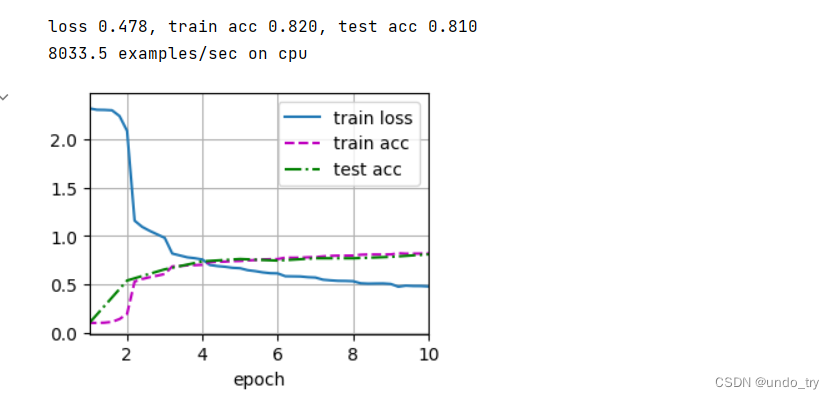
注:卷积神经网络通俗解释
大白话讲解卷积神经网络工作原理
从“卷积”、到“图像卷积操作”、再到“卷积神经网络”,“卷积”意义的3次改变
